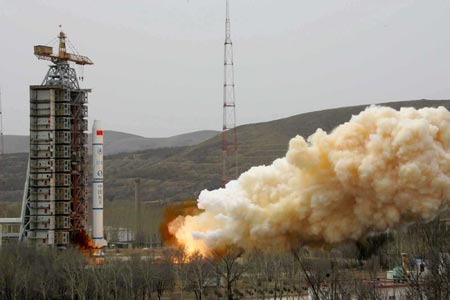In 2006, China continued to enhance its R&D capacities, further narrowing the gap with developed countries. With science and technology playing a crucial role in social and economic development, a new market-based innovation system has been established. Meanwhile, China released it long- and middle-term sci-tech development program and launched in succession 16 key projects including the exploitation of large oil-gas fields and coal seam gas resources, establishment of new-generation wireless broadband communications networks, building of large commercial aircraft and manned space flight and lunar exploration. Great strides were also made in developing high-performance computers, super hybrid rice strains, third-generation mobile telecom solutions and digital television.
 |
A Marine-IB satellite is successfully launched from the Taiyuan Satellite Launch Center on April 11, 2007.
The country's expenditures on R&D activities stood at 294.3 billion yuan in 2006, up 20.1 percent over the previous year, accounting for 1.41 percent of the national gross domestic product. Of this, 14.8 billion yuan went to basic research programs. A total of 1,409 projects under the National Key Technology Research and Development Program and 2,841 projects under the Hi-tech Research and Development Program (the 863 Program) were implemented. The year 2006 also saw the establishment of seven new national engineering research centers and three national engineering laboratories. The number of state-validated enterprise-affiliated technical centers reached 438 at the end of 2006. Through the year, 33,000 scientific research results were recorded at or above the provincial- or ministerial-level. Altogether 573,000 patent applications were received from home and abroad, of which 82.1 percent or 470,000 were made by domestic applicants. Of the 210,000 patent applications for new inventions, Chinese residents submitted 58.1 percent or 122,000. A total of 268,000 patents were authorized in the year, with 224,000, or 83.5 percent of the total, going to domestic applicants. Domestic patents, standing at 25,000, made up 43.4 percent of the 58,000 patents authorized for new inventions. A total of 206,000 technology transfer contracts were signed, involving a transaction value of 181.8 billion yuan, up 20.4 percent year on year.
National Science and Technology Awards
At a ceremony held in Beijing on February 27, 2007, the Chinese Government offered the National Science and Technology Awards for 2006 to prominent scientists and enterprises. Li Zhensheng, an academician with the Chinese Academy of Sciences who has developed fine strains of wheat through distant hybridization and contributed to China's food security, won the top prize. More than 326 projects won the first and second prizes in the National Natural Science Award, the National Technology Invention Award and the National Technology Progressive Award categories. Also, two foreign scientists were recognized for their contributions to China's scientific and technological progress.
National Key Technology Research and Development Program
In February 2007, the National Key Technology and Development Program, worth nearly 30 billion yuan, was formally launched. Before that, the Ministry of Science and Technology promulgated a guideline for carrying out the program in July 2006.
The program, aimed at tackling major scientific and technical challenges in China's social and economic development, is an follow-up action plan of the National Long- and Middle-term Sci-tech Development Program (2006-20) and mainly focuses on the development and application of technologies for common use and transformation of imported technologies, in a bid to improve the country's industrial competitiveness and boost coordinated economic and social development.
The program has four targets: initially alleviating energy and resource constraints on social and economic development and rectifying the practice of developing at the expense of environment; enhancing competitiveness of core industries; raising the overall scientific and technical level in public services, and strengthening the R&D capacities of enterprises. A total of 147 projects in 11 areas have been included in the program.





